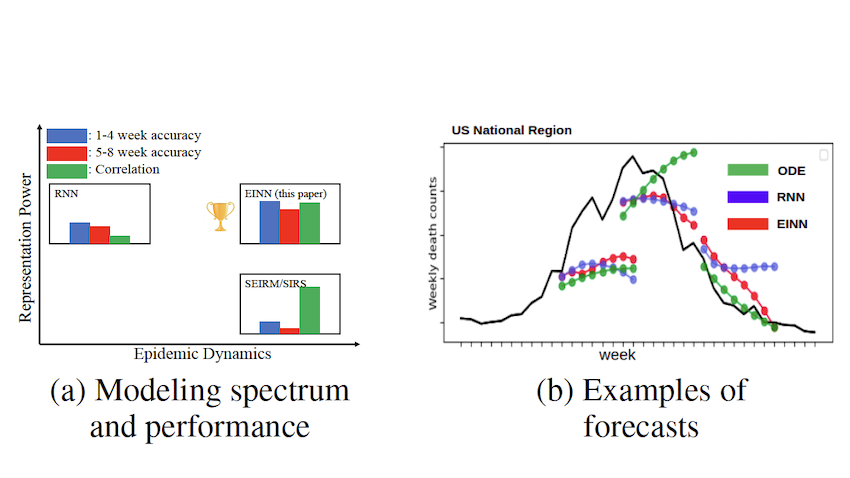
New Hybrid Machine Learning Framework Extends Range of Accurate Epidemic Forecasting
Community leaders and public health officials may soon have more time to plan for Covid and flu outbreaks thanks to a new machine learning (ML) framework that is improving the accuracy of long-range epidemic forecasting.
That is exactly what researchers at Georgia Tech’s School of Computational Science and Engineering (CSE) have developed through EINNs, Epidemiologically-Informed Neural Networks.
Along with proving its ability to improve accuracy in long-term epidemic forecasting, EINNs has implications in artificial intelligence (AI) by leading a path toward optimization for current models based on neural networks and differential equations to follow.
“To generate trustworthy epidemic forecasts, more than just data may be required,” said Alexander Rodríguez, a CSE Ph.D. student and EINNs researcher. “In our paper, we tackle this challenge by introducing a methodology to enable better integration of epidemiological knowledge and deep neural networks. This integration can help neural networks predict farther into the future.”
Joining Rodríguez on the EINNs team from the School of CSE are Ph.D. student Jiaming Cui and Associate Professor B. Aditya Prakash. The trio partnered with Virginia Tech Professor Naren Ramakrishnan and Bijaya Adhikari, an assistant professor at the University of Iowa, to develop EINNs.
In their study, all models, including EINNs, made eight-week forecasts for Covid-19 and flu, in two time periods. The team’s testing period for Covid-19 forecasting spanned Sept. 2020 to March 2021, which encompassed the entire Delta variant wave. For flu, the period lasted from Dec. 2017 to May 2018.
When testing EINNs in forecasting Covid-19 and flu, the framework resulted in improved accuracy of up to 55% of recurrent neural network models, while also increasing correlation with epidemic trends. EINNs also demonstrated 77% less error in comparison to traditional mechanistic epidemiological models based on ordinary differential equations.
These results show promise in forecasting multiple diseases at the same time from a longer perspective. This could prevent future hardships, like the 2022 “tripledemic” of COVID-19, flu, and respiratory syncytial virus (RSV).
As a result of the success of the framework’s design, and its potential for improving epidemic forecasting, the research team presented EINNs at the 37th Association for the Advancement of Artificial Intelligence (AAAI) 2023 conference in Washington, D.C. Here, the conference committee assigned EINNs to the AI for Social Impact track.
“Predicting and preventing epidemics are major challenges for the World Health Organization and the Centers for Disease Control and Prevention, with far-reaching effects on health, economy, and social well-being,” Rodríguez said. “Forecasting with EINNs allows us to see further into the future, which it critical to planning and decision-making in public health.”

Part of the beauty of EINNs is its incorporation of the best aspects from neural networks and mechanistic models, an idea borrowed from physics-informed neural networks. The team mentions in their study that the goal was not to compete with the models, but rather to develop a method for consistently good performance in accuracy and correlation.
Current neural network models are good at short-term forecasting, typically one to four weeks, but do not have any knowledge on epidemic dynamics. As a result, they often lose accuracy in long-term forecasting.
Mechanistic models, on the other hand, contain this knowledge, making them a welcomed addition to deep neural networks for long-term epidemic forecasting. At the same time, mechanistic models have difficulty ingesting some datasets, like social media data. EINNs enables such models to incorporate these datasets better through neural networks.
In total, the research team made 5,696 predictions per tested model, including EINNs. This required training each model more than 700 times. Though computationally expensive, this developed the AI that ultimately led the team’s success.
To accomplish this, the team tested models on four Intel Xeon E7-4850 CPUs, boosted by four NVDIA Tesla V100 DGXS 32GB GPUs. With code written in PyTorch, the GPUs completed training of each predictive task in about 30 minutes.
“Current ML modes don’t utilize domain knowledge embedded in epidemiological models and we wanted to bridge that gap,” Rodríguez said. “To accomplish this, we took inspiration from recent work in scientific AI and developed new techniques. We incorporate this mechanistic knowledge by carefully matching so-called gradients of epidemic variable through transfer learning.”


